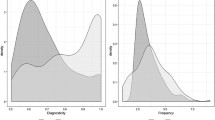Abstract
In the present study, we examined error detection/correction during collaborative writing. Subjects were asked to identify and correct errors in two contexts: a passage written by the subject (familiar text) and a passage written by a person other than the subject (unfamiliar text). A computer program inserted errors in function words prior to the proofreading of both passages. The errors preserved the lexical status of the original words, making the errors difficult to detect by commercially available spell-checking functions. The two passages permitted us to ask whether unfamiliar errors (i.e., errors not committed by the proofreader) would be easier to detect/correct in a familiar text than in an unfamiliar text. It was hypothesized that the proofreader’s substantial familiarity with his/her own writing might make the unfamiliar errors salient, thereby enhancing error detection. Alternatively, this elevated familiarity could impair error detection by increasing the predictability of the text being proofread and thus the likelihood of overlooking errors. The results provided support for the “perceptual salience” account and suggested that an environment that diminishes the proofreaders’ familiarity with their own writing (e.g., substantive typescript changes) can also diminish the salience of the errors committed by others.
Similar content being viewed by others
References
Balota, D. A., Pollatsek, A., & Rayner, K. (1985). The interaction of contextual constraints and parafoveal visual information in reading. Cognitive Psychology, 17, 364–390.
Carpenter, P. A., & Just, M. A. (1983). What your eyes do while your mind is reading. In K. Rayner (Ed.), Eye movements in reading: Perceptual and language processes (pp. 275–307). New York: Academic Press.
Chodorow, M. (2006). Write & detect [Computer software]. New York: Hunter College.
Daneman, M., & Stainton, M. (1993). The generation effect in reading and proofreading. Is it easier or harder to detect errors in one’s own writing? Reading and Writing: An Interdisciplinary Journal, 5, 297–313.
Ehrlich, S. F., & Rayner, K. (1981). Contextual effects of word perception and eye movements in reading. Journal of Verbal Learning and Verbal Behavior, 20, 641–655.
Hacker, D. J., Plumb, C., Butterfield, E. C., Quathamer, D., & Heineken, E. (1994). Text revision: Detection and correction of errors. Journal of Educational Psychology, 86, 65–78.
Levy, B. A. (1983). Proofreading familiar text: Constraints on visual processing. Memory and Cognition, 11, 1–12.
Levy, B. A., & Begin, J. (1984). Proofreading familiar text: Allocating resources to perceptual and conceptual processes. Memory and Cognition, 12, 621–632.
Levy, B. A., Di Persio, R., & Hollingshead, A. (1992). Fluent rereading: Repetition, automaticity, and discrepancy. Journal of Experimental Psychology: Learning, Memory, and Cognition, 18, 957–971.
Levy, A. B., & Kirsner, K. (1989). Reprocessing text: Indirect measures of word and message level processes. Journal of Experimental Psychology: Learning, Memory, and Cognition, 15, 407–417.
Levy, A. B., Newell, S., Snyder, J., & Timmins, K. (1986). Processing changes across reading encounters. Journal of Experimental Psychology: Learning, Memory, and Cognition, 12, 467–478.
Levy, A. B., Nicholls, A., & Kohen, D. (1993). Repeated readings: Process benefits for good and poor readers. Journal of Experimental Child Psychology, 56, 303–327.
Logan, G. D. (1988). Toward an instance theory of automation. Psychological Review, 95, 492–527.
Logan G. D. (1990). Repetition priming and automaticity: Common underlying mechanisms? Cognitive Psychology, 22, 1–33.
Lubow, R. E., & Kaplan, O. (1997). Visual search as a function of type of prior experience with target and distractor. Journal of Experimental Psychology: Human Perception and Performance, 23, 14–24.
Mruczek, R. E. B., & Sheinberg, D. L. (2005). Distractor familiarity leads to more efficient visual search for complex stimuli. Perception & Psychophysics, 67, 1016–1031.
Noël, S., & Robert, J.-M. (2004). Empirical study on collaborative writing: What do co-authors do, use, and like? Computer Supported Cooperative Work, 13, 63–89.
Perfect, T. J., & Askew, C. (1994). Print adverts: Not remembered but memorable. Applied Cognitive Psychology, 8, 693–703.
Pilotti, M., Chodorow, M., & Thornton, K. C. (2004). Error detection in text: Do feedback and familiarity help? Journal of General Psychology, 131, 242–267.
Pilotti, M., Chodorow, M., & Thornton, K. (2005). Effects of familiarity and type of encoding on proofreading of text. Reading and Writing: An Interdisciplinary Journal, 18, 325–341.
Pilotti, M., Chodorow, M., & Maxwell, K. (2006). Does the effect of familiarity change with encoding task and time? The Journal of General Psychology, 133, 287–299.
Plumb, C., Butterfield, E. C., Hacker, D. J., & Dunlosky, J. (1994). Error correction in text: Testing the processing-deficit and knowledge-deficit hypotheses. Reading and Writing: An Interdisciplinary Journal, 6, 347–360.
Rayner, K., & Well, A. D. (1996). Effects of contextual constraints on eye movements in reading: A further examination. Psychonomic Bulletin & Review, 3, 504–509.
Shipley, W. C. (1940). A self-administering scale for measuring intellectual impairment and deterioration. Journal of Psychology, 9, 371–377.
Wang, Q., Cavanagh, P., & Green, M. (1994). Familiarity and pop-out in visual search. Perception and Psychophysics, 56, 495–500.
Warrington, E. K., & Weiskrantz, L. (1968). New method of testing long-term retention with special reference to amnesic patients. Nature, 217, 972–974.
Acknowledgements
We thank Radoslav Petrov and Sunitha Kumar for assistance in conducting this study and for helpful comments on earlier versions of the manuscript.
Author information
Authors and Affiliations
Corresponding author
Rights and permissions
About this article
Cite this article
Pilotti, M., Chodorow, M. Error detection/correction in collaborative writing. Read Writ 22, 245–260 (2009). https://doi.org/10.1007/s11145-007-9110-x
Received:
Accepted:
Published:
Issue Date:
DOI: https://doi.org/10.1007/s11145-007-9110-x




